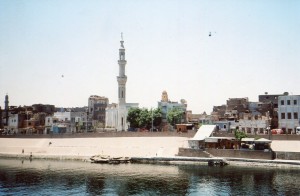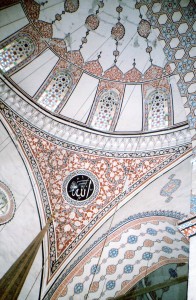A traditional Islamic community’s skyline suggests hidden depths.
The narrow winding streets don’t offer a long linear perspective that lets you make sense of a big section of the whole. The most prominent building is the mosque’s minaret. So far, we’re on the same ground as medieval European towns, which were dominated by church spires. But Islamic calligraphy enhances the sense that reality has a lot of inner depth. Let’s try to penetrate some of it.
Islam has many myths about mystical origins of writing. One says that God created the angels in accordance with the names and ordinal numbers of letters so they could glorify Him by reciting the Koran. Allah told them, “Praise me, I am Allah.” The first letter to prostrate was A (alif). God said, “Because you prostrated to glorify me first, I shall appoint you the first letter of my name, and of the alphabet.”
And so in the roundel in the mosque in Istanbul (pictured above), we can see Allah being spelled, with alif standing on the right, tall and straight, leading the rest of the letters.
So letters are not distinct entities with equal value, as they have usually been in the West. They come from God, and the first letter is especially close to Him. A lot of concepts emphasize what’s close to Him, and ways that writing expresses it.
1. Dikhr–remembrance. As in many spiritual traditions, Muslims try to develop constant remembrance of divinity. They can do this by reciting Koranic verses. But some have noted that your in-breath and out-breath respectively sound like the first and last syllables of Allah. So does the heart’s lub-dub–the body automatically encourages you to remember your creator, by His grace.
2. The written form of Allah resembles the way Muslims pray (salat). This is one of the Five Pillars of Faith. The person faces Mecca, and takes turns standing, kneeling and prostrating. Alif begins God’s written form by standing. The two L’s appear to kneel. A recent post described how communal prayer is one of the most basic expressions of Islamic thought–all believers form a circle and face the same point to praise the Creator. The most sacred writing expresses this same idea. Both reflect each other and remind people that God is the center of everything.
3. Another recent post explains that circles are often conceived more in terms of their centers than their edges. Creation and God’s power come from the center. Calligraphy can encourage people to be more conscious of the center.
So Islam has a rich network of ideas to treat letters as coming from God, and leading His creation back to Him. The West has very strong traditions of seeing reality as a system of linear relationships. Ancient Greek temples, and Gothic cathedrals reinforce this sensibility. In Islam, the direct relationship with God takes precedence. The alphabet, geometry, mosque architecture, communal prayer, and even a town’s skyline reflect this. If you’re ever in a Middle Eastern town, try to jettison the focus on linearity for a while, and you’ll see the world through another very creative culture’s eyes.


Comments on this entry are closed.